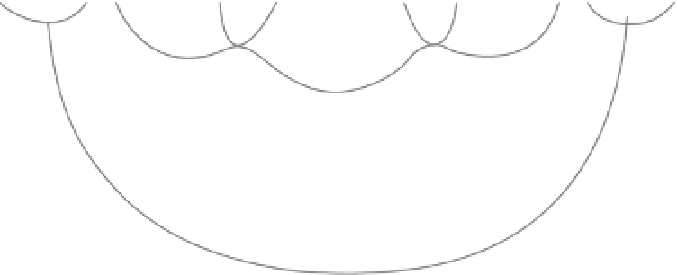Environmental Engineering Reference
In-Depth Information
Potential distribution on the surface
of the theoretical flow region
Figure 5.3
Groundwater fl ow systems in a homogeneous subsoil. Higher order systems lie nested within lower order
systems. (From Toth 1963. Reproduced by permission of American Geophysical Union.)
constitute up to 99% of all solutes in water. The most
common cations are Na
+
, K
+
, Mg
2+
and Ca
2+
whereas
HCO
3
−
, Cl
−
and SO
4
2−
are the most important anions.
The chemical composition of ground- and surface
water differs from site to site and can be used as a 'fi n-
gerprint' to trace its origin (Stuyfzand 1989; Komor
1994). Groundwater shows a very typical evolution in
water composition, especially in areas with thick layers
of mineral-poor sand (Figure 5.4). Both rainwater and
groundwater of upper layers are generally very poor in
dissolved solutes. As it penetrates deeper this water
reaches layers where soluble minerals have not been
washed out and these go into solution and increase the
mineral load. Quantitatively the most important miner-
als are several Ca
2+
compounds, especially CaCO
3
and
CaSO
4
, but other minerals can also be found. If ground-
water fl ows from different systems come to the surface
alongside each other (see Figure 5.3), this can result in
a steep hydrochemical gradient.
tion of water from areas with suffi cient precipitation,
for example mountains, to sites with defi cits. Examples
can be found in the south-western United States, where
water from the Colorado River is used for irrigation so
intensively that the river dries up completely before it
reaches the Salton Sea. In recent times there is also a
development towards transporting water to areas
where there are only temporal water shortages (i.e.
during the dry season). For example, in the Nether-
lands huge canals enable the transport of water from
the River Rhine to all corners of the country in order
to optimize conditions for crop growth throughout the
year. The impact this may have on the rearrangement
of aquatic plant and animal communities is still largely
unexplored (see also Chapter 17).
Not only a redistribution of water but also the use of
fertilizers has enabled an enormous increase in crop pro-
duction in previously marginal areas. The yearly nitro-
gen surplus on agricultural fi elds in Flanders, for
instance, steadily increased from an estimated 15-30 kg
ha
− 1
yr
− 1
in 1900 to 329 kg ha
− 1
yr
− 1
in 1990 and then
decreased again to 144 kg ha
− 1
yr
− 1
in 2006 (see website
in the appendix at the end of this chapter). In many
countries of the world a similar trend can be witnessed
and this has resulted in an average productivity increase
in commercial crops. For instance, for the European
Union there has been a yearly growth of 1.9% ha
− 1
yr
− 1
between 1950 and 1991. The effects of these develop-
ments are not restricted to agricultural areas; the
yearly nitrogen load from agricultural sources into the
By h uman a ctivities
Apart from sometimes quite signifi cant human impact
on natural fl ows, huge amounts of matter are also
intentionally transported by humans, especially in
connection to agriculture. At present, in quantitative
terms the most important fl ows are transport of water
for irrigation and of fertilizer to increase crop produc-
tion in less fertile areas. Water transport is practised
mainly in warmer climates and consists of a redistribu-





























